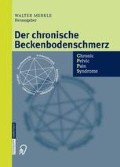Zusammenfassung
Patienten mit chronischen Beckenboden-schmerzen haben häufig die Vorstellung, da „müsse doch ein Nerv eingeklemmt sein`, der den Schmerz verursache. Tatsächlich lässt sich nur bei einem sehr geringen Teil dieser Patienten eine neurogene Läsion sichern oder zumindest mit großer Wahrscheinlichkeit vermuten. Um den Patienten unnötige Eingriffe, z. B. Dekompressions-oder Bandscheibenoperationen, zu ersparen, ist die exakte Zuordnung der Schmerzen zu einem Nerven, einer Nervenwurzel, dem Plexus lumbosacralis oder einer spinalen oder zentralen Struktur erforderlich.
Access this chapter
Tax calculation will be finalised at checkout
Purchases are for personal use only
Preview
Unable to display preview. Download preview PDF.
Literatur
Alevizon SJ, Finan MA (1996) Sacrospinous colpopexy: management of postoperative pudendal nerve entrapment. Obstet Gynecol 88(4 Pt 2): 713–715
Amarenco G, Kerdraon J, Bouju P, Le Bedut C, Cocquen AL, Bosc S, Goldet R (1997) Treatment of perineal neuralgia caused by involvement of the pudendal nerve. Rev Neurol (Paris) 5:331–334
Attal N (2001) Pharmacologic treatment of neuropathic pain. Acta Neurol Belg 101(1):53–64
Chiu WS (1976) The syndrome of retroperitoneal hemorrhage and lumbar plexus neuropathy during anticoagulant therapy. South Med J 69 (5): 595–599
Finsen V (2001) Corticoid injection for coccygodynia. Tidsskr Nor Laegeforen 120:121
Jost WH (1997) Kompressionssyndrom des N. pudendus. In: Jost (Hrsg) Neurologie des Beckenbodens. Chapman & Hall, Weinheim, S 315–317
Jost WH, Schimrigk K (1994) A new method to determine pudendal nerve motor latency and central motor conduction time to the external anal sphincter. Electroenceph Clin Neurophysiol 93:237–239
Kiff ES, Swash M (1984) Normal proximal and delayed disal conduction in the pudendal nerves of patients with idiopathic (neurogenic) faecal incontinence. J Neurol Neurosurg Psychiatry 47: 820–823
Kovacs P, Gruber H, Piegger J, Bodner G (2001) New, simple ultrasound-guided infiltration of the pudendal nerve: ultrasonographic technique. Dis Colon Rectum 44(9):1381–1385
Krahenbuhl L, Striffeler H, Baer HU Buehler MW (1997) Retroperitoneal endoscopic neurectomy for nerve entrapment after hernia repair Br J Surgery 84(2):216–219
Matzel KE, Stadelmaier U, Hohenfellner M, Hohenberger W (2001) Chronic sacral spinal nerve stimulation for fecal incontinence: long-term results with foramen and cuff electrodes. Dis Colon Rectum 44(1):59–66
Mauillon J, Thoumas D, Leroi AM, Freger P, Michot F, Denis P (1999) Results of pudendal nerve neurolysis-transposition in twelve patients suffering from pudendal neuralgia. Dis Colon Rectum 42(2):186–192
Morren GL, Walter S, Lindehammar H, Hall-book O, Sjodahl R (2001) Latency of compound muscle potentials of the anal sphincter after magnetic sacral stimulation. Muscle Nerve 24(9):1232–1235
Mumenthaler M (1993) Läsionen des Plexus lumbosacralis. In: Mumenthaler M, Schliack H(Hrsg) Läsionen peripherer Nerven. Thieme Verlag, Stuttgart New York, S 315–321
Mumenthaler M (1993) Läsionen einzelner Nerven des Beinplexus und der unteren Extremität. In: Mumenthaler M, Schliack H (Hrsg) Läsionen peripherer Nerven. Thieme Verlag, Stuttgart New York, S 326–328
Sato T, Nagai H (2002) Sacral magnetic stimulation for pain relief from pudendal neuralgia and sciatica. Dis Colon Rctum 45:280–282
Shafik A (1919) Pudendus-Kanal-Syndrom. Beschreibung eines neuen Syndroms und seine Behandlung. Bericht über sieben Fälle. Coloproctology 13:102–109
Siegel S, Paszkiewicz E, Kirkpatrick C, Hinkel B, Oleson K (2001) Sacral nerve stimulation in patients with chronic intractable pelvic pain. J Urol 166(5):1742–1745
Silbert PL, Dunne JW, Edis RH, Stewart-Wynne EG (1991) Bicycling induced pudendal nerve pressure neuropathy. Clin Exp Neurol 28:191–196
Thoumas D, Leroi AM, Mauillon J, Muller JM, Benozio M, Denis P, Freger (1999) Pudendal neuralgia: CT-guided pudendal nerve block technique. Abdom Imaging 24(3):309–312
Wiesner A, Jost WH (2001) Vaginal versus anal stimulierte Pudenduslatenz - ein Vergleich. Akt Neurol 28:388–390
Editor information
Editors and Affiliations
Rights and permissions
Copyright information
© 2003 Springer-Verlag Berlin Heidelberg
About this chapter
Cite this chapter
Wiesner, A., Jost, W. (2003). Der chronische Beckenbodenschmerz aus der Sicht der Neurologie. In: Merkle, W. (eds) Der chronische Beckenbodenschmerz. Steinkopff, Heidelberg. https://doi.org/10.1007/978-3-642-57396-5_6
Download citation
DOI: https://doi.org/10.1007/978-3-642-57396-5_6
Publisher Name: Steinkopff, Heidelberg
Print ISBN: 978-3-642-63256-3
Online ISBN: 978-3-642-57396-5
eBook Packages: Springer Book Archive

